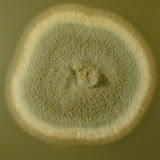 The bane of military quartermasters may soon be a boon to biofuels producers. The genome analysis of a champion biomass-degrading fungus has revealed a surprisingly minimal repertoire of genes that it employs to break down plant cell walls, highlighting opportunities for further improvements in enzymes customized for biofuels production. The results were published online May 4 in Nature Biotechnology by a team of government, academic, and industry researchers led by the U.S. Dept. of Energy Joint Genome Institute (DOE JGI) and Los Alamos National Laboratory (LANL).
The bane of military quartermasters may soon be a boon to biofuels producers. The genome analysis of a champion biomass-degrading fungus has revealed a surprisingly minimal repertoire of genes that it employs to break down plant cell walls, highlighting opportunities for further improvements in enzymes customized for biofuels production. The results were published online May 4 in Nature Biotechnology by a team of government, academic, and industry researchers led by the U.S. Dept. of Energy Joint Genome Institute (DOE JGI) and Los Alamos National Laboratory (LANL).The discovery of Trichoderma reesei, the target of the published analysis, dates back to World War II, when it was identified as the culprit responsible for the deterioration of fatigues and tents in the South Pacific. This progenitor strain has since yielded variants for broad industrial applications and is known today as an abundant source of enzymes, particularly cellulases and hemicellulases, currently being explored to catalyze the deconstruction of plant cell walls as a first step towards the production of biofuels from lignocellulose.
“The information generated from the genome of T. reesei provides us with a roadmap for accelerating research to optimize fungal strains for reducing the current prohibitively high cost of converting lignocellulose to fermentable sugars,” says Eddy Rubin, DOE JGI Director and one of the paper’s senior authors. “Improved industrial enzyme ‘cocktails’ from T. reseei and other fungi will enable more economical conversion of biomass from such feedstocks as the perennial grasses Miscanthus and switchgrass, wood from fast-growing trees like poplar, agricultural crop residues, and municipal waste, into next-generation biofuels. Through these incremental advances, we hope to eventually supplant the gasoline-dependent transportation sector of our economy with a more carbon-neutral strategy.”
http://www.nature.com/nbt/journal/vaop/ncurrent/abs/nbt1403.html

No comments:
Post a Comment